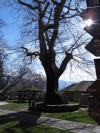
Metsovo. (1330k)
From the Metsovo entry in Wikipedia:
Metsovo is a town in Epirus, in the mountains of Pindus in northern Greece, between Ioannina to the west and Meteora to the east.
The largest center of Aromanian (Vlach) life in Greece, Metsovo is a large regional hub for several small villages and settlements in the Pindus region, and it features many shops, schools, offices, services, museums, and galleries. The economy of Metsovo is dominated by agriculture and tourism, the latter of which flourishes in winter.
In the 15th century Metsovo came under Ottoman rule and became part of the Sanjak of Ioannina. Throughout the late period of Ottoman rule (18th century-1913) the Greek and Aromanian population of the region (Northern Pindus) suffered from Albanian raiders. On one occasion, during the local Greek revolt of 1854, the town was plundered by both Ottoman troops and the men of Theodoros Grivas, a former general in the Greek military, during their struggle for control of the town. During the First Balkan War, Metsovo was burnt by raiding bands. In the last 10 days of October 1912, military volunteers from Crete, together with about 340 soldiers of the tactical Greek army under the command of Lieutenant Colonel Mitsas, advanced through Thessaly to the then Greek-Turkish border along the mountains east of Metsovo. On October 31, 1912, the Greek troops assisted by rebel groups from Epirus and volunteers from Metsovo, having crossed the Katara-Zygos mountain ridge overnight, attacked the Turkish garrison of Metsovo, which then comprised 205 soldiers and two cannons. The battle lasted until 16:00. when the Ottoman soldiers inside the besieged Turkish garrison raised a white flag and surrendered.
Socially, the residents of Metsovo, up until the beginning of the 20th century, were divided into three classes: the "arhontzi" (arxondzɨ), the "vinitsi" (vinitsɨ) and the "algi" (alɟi) or, mockingly, "gizari" (ɟizari). This socioeconomic stratification developed during the Ottoman occupation.
The arhontzi were the wealthiest part of society. Their revenues derived from wholesale and retail commercial activities. Although locally very powerful, they were not a closed group in terms of social mobility. Wealth gave anyone the right to climb up the social ladder to the next higher level, although such ascent often gave rise to serious conflicts.
The vinitsi comprised the middle and lower classes of the settlement that were not occupied in livestock breeding. It mostly included farmers, small business owners, technicians, mule drivers, and small-scale merchants. Despite the economic and professional diversification among the vinitsi, they saw themselves as a unified social class, which was evident in their social relations. For example, they would marry among themselves but never with members of the algi.
The algi were the class of traveling sheepherders, whose occupation was large-scale shepherding, livestock breeding, as well as woodcarving. They had set rules regarding the social roles of their members, and a strict patriarchal structure that governed their class.
All pictures are © Dr. Günther Eichhorn, unless otherwise noted.








This page contains 8 pictures
Here are the links to the other main pages on Greece:
Page last updated on Fri Jul 8 18:54:19 2022 (Mountain Standard Time)
Metsovo on iac35.guenther-eichhorn.com